Fresh Thai Rice Noodles With Sauce



One of the most popular dishes in Thailand is kanom jeen, which is fresh rice noodles served with a variety of sauces. The name can be quite misleading since kanom means dessert and jeen means Chinese, in Thai. Kanom jeen is not a Chinese dessert as the name suggests. In fact, it's a dish that can be found all over Thailand.
It is usually sold at specialty restaurants called ran kanom jeen, where they serve rice noodles with several choices of sauces and plenty of vegetables. The veggies can either be fresh, boiled or pickled. It's also possible to eat kanom jeen at regular restaurants that have it on the menu. However, there will be a limited selection of sauces and vegetables.
What Is Kanom Jeen?
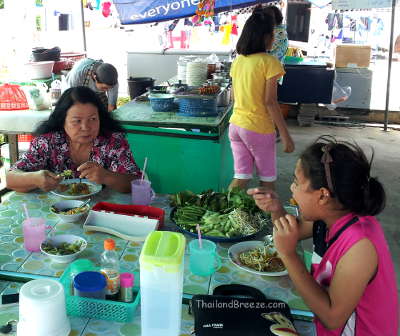
It's a noodle dish that is made up of 2 parts, noodles and sauce. Actually, the name kanom jeen refers to the noodles. It may look like other kinds of noodles to you, but it's a unique fresh rice noodle that is thin and soft.
The main ingredient is rice flour. Traditionally, it was quite a process to make the noodles. The first step was to soak the rice and grind it.
Then, the rice flour was kneaded, steamed, pounded and kneaded again. After that, it was pressed through a grid of small holes into boiling water. The last step was to cool it off in cold water and to place the noodles in a basket. This entire process resulted in soft fresh rice noodles. Today, with the help of machines, it's a whole lot simpler and less time-consuming.
There are two kinds of kanom jeen, regular and fermented. The latter is made of fermented rice flour, which gives it a yellowish color and a sour smell. Nowadays, fermented noodles are rare.
Kanom Jeen Sauces
Kanom jeen is served with different kinds of sauces. The most popular ones are based on fish and peanuts. Other than that, green curry and fish stomach are also common. Normally, Thais put one sauce on the noodles. However, some prefer to mix two sauces, such as fish and peanuts or green curry and fish stomach.
Most of these sauces are based on chili paste, that is made from dried red chili, shrimp paste, red onion and garlic. In addition, each sauce has certain ingredients that make them unique.
It's pretty easy to learn the names of these dishes. Simply say kanom jeen followed by the name of the sauce. For example, fresh rice noodles with fish-based sauce is called kanom jeen nam ya. Similarly, fresh rice noodles with green curry is called kanom jeen kaeng keo wan.
Fish-Based Sauce Or Nam Ya
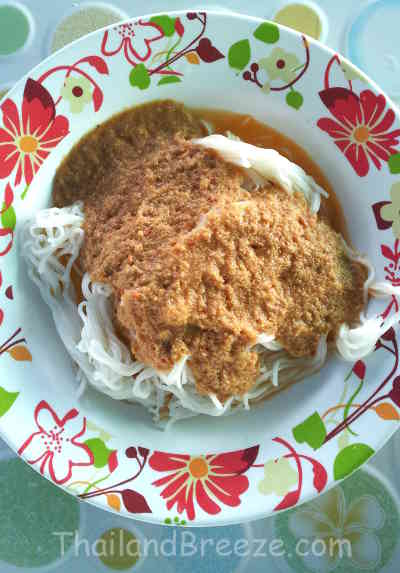
I'd say that nam ya is the most authentic sauce for kanom jeen. The flavor of this fish-based sauce is distinct because of the pungent fingerroot, which is called krachai in Thai.
Common variations of nam ya are nam ya pa and nam ya tai. Nam ya pa is a clearer sauce since it doesn't have coconut milk. It is hot from pepper, but not as spicy as fish stomach sauce.
Nam ya tai indicates that it's a southern dish, as the word tai means south. Since Thai southerners love to season their food with turmeric, it usually replaces the fingerroot and this is why the sauce has a shade of yellow.
Kanom jeen nam ya is usually served with fresh lemon basil leaf, called bai maenglak.
Peanut Sauce Or Nam Phrik

Nam phrik is the mildest sauce eaten with kanom jeen, since only a small amount of red chili has been added. Some vendors replace red chili with chili paste, which is even milder.
It's somewhat similar to the peanut sauce that is is served with marinated grilled meat, called satay. That is because the main ingredients in both sauces are coconut milk and peanuts. Nam phrik is usually eaten with boiled swamp cabbage, that is cut in small pieces.
Note that the word nam phrik also means chili paste that Thais eat with rice and vegetables.
Green Curry Or Kaeng Keo Wan
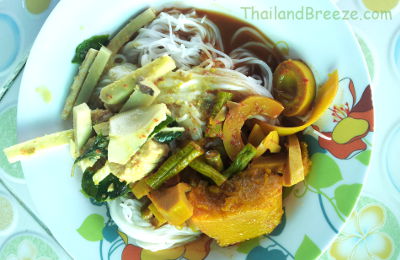
Kaeng keo wan is one of the most popular curries in Thailand. It gets its green color from the fresh green chilies used in the chili paste base. It can be made with either chicken, pork, beef or fish meat balls.
The most common vegetables in kaeng keo wan are Thai egg plant, small green eggplant and sweet basil called horapha.
This is a photo of kanom jeen topped with green curry (on the left) and fish stomach sauce (on the right.)
Fish Stomach Sauce Or Kaeng Tai Pla
This is a southern specialty that is usually burning hot. In other words, it's the spiciest sauce eaten with kanom jeen. The name literally means fish kidney soup, but it's actually made from fish stomach preserved in salt water.
Southerners call it kaeng pung pla since the word pung means stomach. Other main ingredients put in kaeng tai pla are pieces of grilled fish meat, bamboo shoots, string beans, winged-beans, Thai eggplants and pumpkin.
Coconut Milk Sauce With Pineapple Or Sao Nam
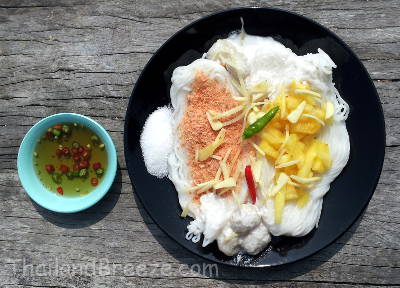
During the traditional Thai New Year or songkran, which is the hottest time of the year, one of the summer dishes is fresh Thai rice noodles with coconut milk, called kanom jeen sao nam. Traditionally, it was served between meals, often in the early afternoon.
The following ingredients are put on a plate: Fresh rice noodles, ripe pineapple, ginger, chili, garlic, lime and dried shrimps. Then, seasoned coconut milk sauce with fish balls is poured on top. It's served with fish sauce that has chili in it.
More About Kanom Jeen
A number of Thais, especially elderly, like to eat kanom jeen with a plain fish sauce of high quality, while others prefer fish sauce with sliced shallots, chilies, lime and some sugar called nam pla phrik.
Basically, any kind of hot soup, curry and sauces go well with kanom jeen.
There can be tiny pieces of fish bones in the fish-based sauces, so be cautious when you eat.
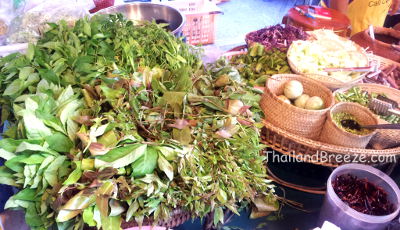
In addition to fresh and pickled vegetables, certain flowers such as blue pea flower can be eaten fresh with kanom jeen.
Vegetarian kanom jeen is usually available at vegetarian restaurants. The main ingredients in the sauce are chopped fresh mushrooms, soy protein and fingerroot.
If you live outside Thailand and want to prepare kanom jeen, use vermicelli or bun instead. Bun is Vietnamese round rice noodles. Otherwise, use Japanese wheat noodles called somen.
One of the most popular dishes in Thailand is kanom jeen, which is fresh rice noodles served with a variety of sauces. The name can be quite misleading since kanom means dessert and jeen means Chinese, in Thai. Kanom jeen is not a Chinese dessert as the name suggests. In fact, it's a dish that can be found all over Thailand.
It is usually sold at specialty restaurants called ran kanom jeen, where they serve rice noodles with several choices of sauces and plenty of vegetables. The veggies can either be fresh, boiled or pickled. It's also possible to eat kanom jeen at regular restaurants that have it on the menu. However, there will be a limited selection of sauces and vegetables.
It is usually sold at specialty restaurants called ran kanom jeen, where they serve rice noodles with several choices of sauces and plenty of vegetables. The veggies can either be fresh, boiled or pickled. It's also possible to eat kanom jeen at regular restaurants that have it on the menu. However, there will be a limited selection of sauces and vegetables.
What Is Kanom Jeen?
 |
It's a noodle dish that is made up of 2 parts, noodles and sauce. Actually, the name kanom jeen refers to the noodles. It may look like other kinds of noodles to you, but it's a unique fresh rice noodle that is thin and soft.
The main ingredient is rice flour. Traditionally, it was quite a process to make the noodles. The first step was to soak the rice and grind it.
Then, the rice flour was kneaded, steamed, pounded and kneaded again. After that, it was pressed through a grid of small holes into boiling water. The last step was to cool it off in cold water and to place the noodles in a basket. This entire process resulted in soft fresh rice noodles. Today, with the help of machines, it's a whole lot simpler and less time-consuming.
There are two kinds of kanom jeen, regular and fermented. The latter is made of fermented rice flour, which gives it a yellowish color and a sour smell. Nowadays, fermented noodles are rare.
The main ingredient is rice flour. Traditionally, it was quite a process to make the noodles. The first step was to soak the rice and grind it.
Then, the rice flour was kneaded, steamed, pounded and kneaded again. After that, it was pressed through a grid of small holes into boiling water. The last step was to cool it off in cold water and to place the noodles in a basket. This entire process resulted in soft fresh rice noodles. Today, with the help of machines, it's a whole lot simpler and less time-consuming.
There are two kinds of kanom jeen, regular and fermented. The latter is made of fermented rice flour, which gives it a yellowish color and a sour smell. Nowadays, fermented noodles are rare.
Kanom Jeen Sauces
Kanom jeen is served with different kinds of sauces. The most popular ones are based on fish and peanuts. Other than that, green curry and fish stomach are also common. Normally, Thais put one sauce on the noodles. However, some prefer to mix two sauces, such as fish and peanuts or green curry and fish stomach.
Most of these sauces are based on chili paste, that is made from dried red chili, shrimp paste, red onion and garlic. In addition, each sauce has certain ingredients that make them unique.
It's pretty easy to learn the names of these dishes. Simply say kanom jeen followed by the name of the sauce. For example, fresh rice noodles with fish-based sauce is called kanom jeen nam ya. Similarly, fresh rice noodles with green curry is called kanom jeen kaeng keo wan.
Fish-Based Sauce Or Nam Ya

I'd say that nam ya is the most authentic sauce for kanom jeen. The flavor of this fish-based sauce is distinct because of the pungent fingerroot, which is called krachai in Thai.
Common variations of nam ya are nam ya pa and nam ya tai. Nam ya pa is a clearer sauce since it doesn't have coconut milk. It is hot from pepper, but not as spicy as fish stomach sauce.
Nam ya tai indicates that it's a southern dish, as the word tai means south. Since Thai southerners love to season their food with turmeric, it usually replaces the fingerroot and this is why the sauce has a shade of yellow.
Kanom jeen nam ya is usually served with fresh lemon basil leaf, called bai maenglak.
Peanut Sauce Or Nam Phrik

Nam phrik is the mildest sauce eaten with kanom jeen, since only a small amount of red chili has been added. Some vendors replace red chili with chili paste, which is even milder.
It's somewhat similar to the peanut sauce that is is served with marinated grilled meat, called satay. That is because the main ingredients in both sauces are coconut milk and peanuts. Nam phrik is usually eaten with boiled swamp cabbage, that is cut in small pieces.
Note that the word nam phrik also means chili paste that Thais eat with rice and vegetables.
Green Curry Or Kaeng Keo Wan

Kaeng keo wan is one of the most popular curries in Thailand. It gets its green color from the fresh green chilies used in the chili paste base. It can be made with either chicken, pork, beef or fish meat balls.
The most common vegetables in kaeng keo wan are Thai egg plant, small green eggplant and sweet basil called horapha.
This is a photo of kanom jeen topped with green curry (on the left) and fish stomach sauce (on the right.)
Fish Stomach Sauce Or Kaeng Tai Pla
This is a southern specialty that is usually burning hot. In other words, it's the spiciest sauce eaten with kanom jeen. The name literally means fish kidney soup, but it's actually made from fish stomach preserved in salt water.
Southerners call it kaeng pung pla since the word pung means stomach. Other main ingredients put in kaeng tai pla are pieces of grilled fish meat, bamboo shoots, string beans, winged-beans, Thai eggplants and pumpkin.
Coconut Milk Sauce With Pineapple Or Sao Nam

During the traditional Thai New Year or songkran, which is the hottest time of the year, one of the summer dishes is fresh Thai rice noodles with coconut milk, called kanom jeen sao nam. Traditionally, it was served between meals, often in the early afternoon.
The following ingredients are put on a plate: Fresh rice noodles, ripe pineapple, ginger, chili, garlic, lime and dried shrimps. Then, seasoned coconut milk sauce with fish balls is poured on top. It's served with fish sauce that has chili in it.
More About Kanom Jeen
A number of Thais, especially elderly, like to eat kanom jeen with a plain fish sauce of high quality, while others prefer fish sauce with sliced shallots, chilies, lime and some sugar called nam pla phrik.
Basically, any kind of hot soup, curry and sauces go well with kanom jeen.
There can be tiny pieces of fish bones in the fish-based sauces, so be cautious when you eat.

In addition to fresh and pickled vegetables, certain flowers such as blue pea flower can be eaten fresh with kanom jeen.
Vegetarian kanom jeen is usually available at vegetarian restaurants. The main ingredients in the sauce are chopped fresh mushrooms, soy protein and fingerroot.
If you live outside Thailand and want to prepare kanom jeen, use vermicelli or bun instead. Bun is Vietnamese round rice noodles. Otherwise, use Japanese wheat noodles called somen.
Most of these sauces are based on chili paste, that is made from dried red chili, shrimp paste, red onion and garlic. In addition, each sauce has certain ingredients that make them unique.
It's pretty easy to learn the names of these dishes. Simply say kanom jeen followed by the name of the sauce. For example, fresh rice noodles with fish-based sauce is called kanom jeen nam ya. Similarly, fresh rice noodles with green curry is called kanom jeen kaeng keo wan.
Fish-Based Sauce Or Nam Ya
 |
I'd say that nam ya is the most authentic sauce for kanom jeen. The flavor of this fish-based sauce is distinct because of the pungent fingerroot, which is called krachai in Thai.
Common variations of nam ya are nam ya pa and nam ya tai. Nam ya pa is a clearer sauce since it doesn't have coconut milk. It is hot from pepper, but not as spicy as fish stomach sauce.
Nam ya tai indicates that it's a southern dish, as the word tai means south. Since Thai southerners love to season their food with turmeric, it usually replaces the fingerroot and this is why the sauce has a shade of yellow.
Kanom jeen nam ya is usually served with fresh lemon basil leaf, called bai maenglak.
Common variations of nam ya are nam ya pa and nam ya tai. Nam ya pa is a clearer sauce since it doesn't have coconut milk. It is hot from pepper, but not as spicy as fish stomach sauce.
Nam ya tai indicates that it's a southern dish, as the word tai means south. Since Thai southerners love to season their food with turmeric, it usually replaces the fingerroot and this is why the sauce has a shade of yellow.
Kanom jeen nam ya is usually served with fresh lemon basil leaf, called bai maenglak.
Peanut Sauce Or Nam Phrik
 |
Nam phrik is the mildest sauce eaten with kanom jeen, since only a small amount of red chili has been added. Some vendors replace red chili with chili paste, which is even milder.
It's somewhat similar to the peanut sauce that is is served with marinated grilled meat, called satay. That is because the main ingredients in both sauces are coconut milk and peanuts. Nam phrik is usually eaten with boiled swamp cabbage, that is cut in small pieces.
Note that the word nam phrik also means chili paste that Thais eat with rice and vegetables.
It's somewhat similar to the peanut sauce that is is served with marinated grilled meat, called satay. That is because the main ingredients in both sauces are coconut milk and peanuts. Nam phrik is usually eaten with boiled swamp cabbage, that is cut in small pieces.
Note that the word nam phrik also means chili paste that Thais eat with rice and vegetables.
Green Curry Or Kaeng Keo Wan
 |
Kaeng keo wan is one of the most popular curries in Thailand. It gets its green color from the fresh green chilies used in the chili paste base. It can be made with either chicken, pork, beef or fish meat balls.
The most common vegetables in kaeng keo wan are Thai egg plant, small green eggplant and sweet basil called horapha.
This is a photo of kanom jeen topped with green curry (on the left) and fish stomach sauce (on the right.)
The most common vegetables in kaeng keo wan are Thai egg plant, small green eggplant and sweet basil called horapha.
This is a photo of kanom jeen topped with green curry (on the left) and fish stomach sauce (on the right.)
Fish Stomach Sauce Or Kaeng Tai Pla
This is a southern specialty that is usually burning hot. In other words, it's the spiciest sauce eaten with kanom jeen. The name literally means fish kidney soup, but it's actually made from fish stomach preserved in salt water.
Southerners call it kaeng pung pla since the word pung means stomach. Other main ingredients put in kaeng tai pla are pieces of grilled fish meat, bamboo shoots, string beans, winged-beans, Thai eggplants and pumpkin.
Coconut Milk Sauce With Pineapple Or Sao Nam

During the traditional Thai New Year or songkran, which is the hottest time of the year, one of the summer dishes is fresh Thai rice noodles with coconut milk, called kanom jeen sao nam. Traditionally, it was served between meals, often in the early afternoon.
The following ingredients are put on a plate: Fresh rice noodles, ripe pineapple, ginger, chili, garlic, lime and dried shrimps. Then, seasoned coconut milk sauce with fish balls is poured on top. It's served with fish sauce that has chili in it.
More About Kanom Jeen
A number of Thais, especially elderly, like to eat kanom jeen with a plain fish sauce of high quality, while others prefer fish sauce with sliced shallots, chilies, lime and some sugar called nam pla phrik.
Basically, any kind of hot soup, curry and sauces go well with kanom jeen.
There can be tiny pieces of fish bones in the fish-based sauces, so be cautious when you eat.

In addition to fresh and pickled vegetables, certain flowers such as blue pea flower can be eaten fresh with kanom jeen.
Vegetarian kanom jeen is usually available at vegetarian restaurants. The main ingredients in the sauce are chopped fresh mushrooms, soy protein and fingerroot.
If you live outside Thailand and want to prepare kanom jeen, use vermicelli or bun instead. Bun is Vietnamese round rice noodles. Otherwise, use Japanese wheat noodles called somen.
Southerners call it kaeng pung pla since the word pung means stomach. Other main ingredients put in kaeng tai pla are pieces of grilled fish meat, bamboo shoots, string beans, winged-beans, Thai eggplants and pumpkin.
Coconut Milk Sauce With Pineapple Or Sao Nam
 |
During the traditional Thai New Year or songkran, which is the hottest time of the year, one of the summer dishes is fresh Thai rice noodles with coconut milk, called kanom jeen sao nam. Traditionally, it was served between meals, often in the early afternoon.
The following ingredients are put on a plate: Fresh rice noodles, ripe pineapple, ginger, chili, garlic, lime and dried shrimps. Then, seasoned coconut milk sauce with fish balls is poured on top. It's served with fish sauce that has chili in it.
The following ingredients are put on a plate: Fresh rice noodles, ripe pineapple, ginger, chili, garlic, lime and dried shrimps. Then, seasoned coconut milk sauce with fish balls is poured on top. It's served with fish sauce that has chili in it.
More About Kanom Jeen
A number of Thais, especially elderly, like to eat kanom jeen with a plain fish sauce of high quality, while others prefer fish sauce with sliced shallots, chilies, lime and some sugar called nam pla phrik.
Basically, any kind of hot soup, curry and sauces go well with kanom jeen.
There can be tiny pieces of fish bones in the fish-based sauces, so be cautious when you eat.

In addition to fresh and pickled vegetables, certain flowers such as blue pea flower can be eaten fresh with kanom jeen.
Vegetarian kanom jeen is usually available at vegetarian restaurants. The main ingredients in the sauce are chopped fresh mushrooms, soy protein and fingerroot.
If you live outside Thailand and want to prepare kanom jeen, use vermicelli or bun instead. Bun is Vietnamese round rice noodles. Otherwise, use Japanese wheat noodles called somen.
Basically, any kind of hot soup, curry and sauces go well with kanom jeen.
There can be tiny pieces of fish bones in the fish-based sauces, so be cautious when you eat.
 |
Vegetarian kanom jeen is usually available at vegetarian restaurants. The main ingredients in the sauce are chopped fresh mushrooms, soy protein and fingerroot.
If you live outside Thailand and want to prepare kanom jeen, use vermicelli or bun instead. Bun is Vietnamese round rice noodles. Otherwise, use Japanese wheat noodles called somen.
